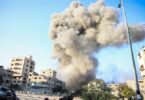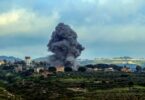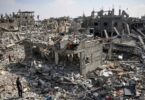Emran Feroz
Foreign invaders and elite urban Afghans have long underestimated or ignored rural Afghanistan, and they have all paid the price of doing so. A few days ago, massive protests took place in the province of Helmand, southern Afghanistan. The night before, Afghan and American forces raided another home in the region. According to locals, they killed several civilians, but this was not the end of the ordeal. The soldiers also abducted two women, and for most of the villagers, this was one step too far.
According to Afghan tradition, entering someone’s home in such a brutal way is an absolute taboo. However, there is something else that further fueled the rage, and that was laying their hands on an Afghan woman – a daughter, a sister or a mother. Reportedly, one of the civilians killed from that night raid was a female medic. It shouldn’t be necessary to underline the importance of such a person in Afghanistan’s rural areas. This, and the abduction of the two women led to widespread protests, and several Afghan politicians had to mediate.
One of those politicians was former president Hamid Karzai who said that such night raids are “a blatant violation of human rights and all norms of Afghan values.” He also demanded that the government release the hostages as soon as possible and to stop similar operations in Afghan villages. However, Karzai is just one of a few people who regularly speak on such issues. At the same time, the government of President Ashraf Ghani always tends to present its own version of events, or to be more precise, its “own truth”. After reports about the recent night raids appeared, the government claimed that it did not attack civilians but a militant hideout and that the abducted women were “female Al-Qaida operatives”.
There are several reasons why this might not be true. First of all, the Kabul government is regularly using the classic “War on Terror” rhetoric to justify all its operations of which many can be reasonably described as war crimes. Too often, civilians are described as “terrorists”, “ISIS militants” or “Taliban fighters” without offering any proof. In most cases, the crime sites are rural areas that are barely visited by journalists or human rights observers, so that in the end, nobody can verify what happened.
In this particular case, the government is talking about Al Qaeda militants while – for years – it is unknown whether Al Qaeda is still present in Afghanistan or not. As I have witnessed myself, even high-ranking NATO officials cannot say if and how many Al Qaeda fighters are on the ground at this very moment in Afghanistan. Last but not least, after the protests in Helmand emerged, the government announced that it would release the abducted women which means that indeed the soldiers raided a civilian home and did not target militants.
Describing attacks as “incidents” is an understatement. In fact, they are state-sponsored acts of terror against Afghanistan’s rural populations. They need to be condemned and investigated, and the culprits must be prosecuted and face trial. However, during the last seventeen years of war, this has not happened, and it is one of the main reasons why we are losing the country’s rural areas.
There are two Afghanistans: We have cities like Kabul where many people care for “modern lifestyles” and watch soap operas or music competitions on Tolo TV and where a small elite benefits from the presence of foreign troops and the military-industrial complex. At the same time, we have many villages – a lot of them not very far from the capital – where the stark reality of poverty and war have is a part of daily life. For years, these places have been bombed and raided by foreign militaries, militias and the Afghan army itself. And today, many of these places are not controlled by the Kabul government or their allies but by Taliban insurgents.
This development is neither new nor a surprise. The gap between urban and rural Afghanistan has always been massive. During the Anglo-Afghan wars in the 19th and 20th century, many royal Afghan elites welcomed British invaders and wanted to adopt a more Western lifestyle while the country’s rural communities led rebellions. Many were left angry and sought revenge as British soldiers raided their homes, raped their women or killed their children. Wazir Mohammad Akbar Khan, son of Emir Dost Mohammad Khan and one of the leading resistance leaders during the 2nd Anglo-Afghan war, was a famed fighter who killed many British soldiers.
But while he is celebrated as a national hero nowadays, many do not like to acknowledge that drones and special forces would likely hunt the prince were he alive today. The gap between rural and urban Afghanistan also became visible in the first quarter of the 20th century when King Amanullah Khan tried to impose a secular and Westernised lifestyle on the Afghan people. In the end, the King was overthrown by large parts of the country’s rural communities that were led by a man called Habibullah Kalakani, or, as some people continue to call him today, “bach-e saqqao” (son of a water carrier). We should not forget that this gap between rural and urban Afghanistan has not been narrowed. When we see pictures from a “liberal” 1980s Kabul we have to realise that during those very years, the country’s rural sites were being bombed by the Red Army and that hundreds of thousands of people were massacred. A picture of a miniskirt-wearing woman walking down the streets of Kabul did not change this reality, and today, very little has changed
We can find modernised Afghans in the capital’s hip coffee shops talking about culture and politics while planning their next trip to Istanbul or Dubai. But they can never hide the lives of all the people who continue to live in war, mayhem and poverty and who cannot afford the luxury to think about TV shows, because they neither have electricity nor television, and they will probably never have one. These are the people who make up an underrepresented majority. As much as Afghanistan’s urban centres have benefited from foreign interventions and invasions, the country’s rural regions have faced devastation, massive poverty and constant war. In this context, many people also tend to forget that Afghanistan is predominantly rural, not urban.
Persistent underrepresentation and massive inequality mean we have lost rural Afghanistan. For that reason, we should not be surprised that, like in the past, it has become a natural playground for insurgent groups and extremists. Unlike Afghans from the cities or those who live in the Kabul bubble, these insurgents and extremists visit the rural areas. They share resources with villagers and, of course, they also exploit their anger and hatred towards a government and a people whose lives do not square with their reality. As long as Afghan villages remain forgotten and suppressed, as long as our ignorance perseveres, things will only get worse, maybe for another one hundred years, or more.






